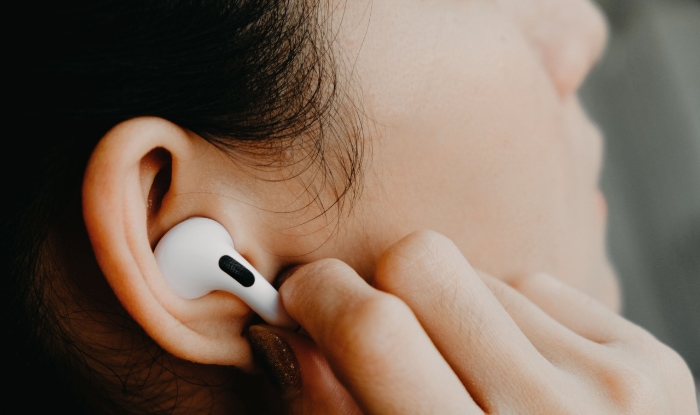How To Keep AirPods From Falling Out: Stop the Drop

Revolutionizing the way we consume audio, these sleek, wireless earbuds have taken the world by storm. Yet, their convenient and cutting-edge design comes with a caveat: a less-than-perfect fit for everyone, resulting in the frustrating experience of them falling out at the most inopportune times.
Losing an earbud during a run or while navigating a crowded subway can be more than just an annoyance; it can be costly. Fortunately, solutions abound.
The Anatomy of the Ear and How AirPods Fit
Human ears are complex structures, with subtle variations that make each one unique. While AirPods are designed to fit the average ear, the one-size-fits-all approach doesn’t always accommodate the wide array of ear shapes and sizes.
Ear Shapes and Sizes
The human ear is composed primarily of three parts—the outer ear, the middle ear, and the inner ear. Each of these components can vary in size and shape from person to person.
Even the size and curvature of the ear canal, where earbuds like AirPods sit, can differ significantly. These variations can influence how well AirPods fit and stay in place.
Design of AirPods
AirPods are built with a universal design intended to fit as many ear types as possible. They come with a rounded earpiece and a slightly angled stem.
The rounded earpiece is meant to sit inside the concha—the bowl-shaped part of your outer ear—while the stem extends downwards. However, because of individual differences in ear anatomy, this design may be too large for some and too small for others, causing the AirPods to be either too tight or too loose.
Why They Fall Out
AirPods falling out is not merely an issue of size or shape mismatch. Other factors come into play, such as motion, sweat, and earwax.
Physical activities like running or jumping can jostle the earbuds loose. Sweating can reduce the grip between the AirPods and the ear canal.
Accumulated earwax can also affect how snugly the AirPods fit. Each of these elements contributes to the overall fit and the likelihood of your AirPods staying in place—or not.
Material Solutions
Keeping your AirPods securely in place can often be achieved with the help of some simple material enhancements. From silicone tips to foam covers and ear hooks, various accessories aim to improve the fit of your AirPods.
Silicone Tips
One of the most popular solutions for improving AirPods’ fit is the use of silicone tips. These are soft, flexible covers that slide onto the earpiece of your AirPods.
The extra grip provided by the silicone can often make all the difference, particularly if your issue is that the AirPods are too loose. Silicone tips are widely available and come in multiple sizes, so you can find a fit that’s just right for you.
Foam Tips
For those looking for an even more customized fit, foam tips might be a suitable option. These tips are made of memory foam that expands to fill the contours of your ear canal, offering both enhanced grip and noise isolation.
While slightly more expensive than their silicone counterparts, foam tips tend to offer a snugger and more secure fit, particularly beneficial during high-motion activities.
Ear Hooks
If your activities involve a lot of movement or vigorous exercise, ear hooks can be a game-changer. These are usually silicone-based attachments that loop around the outer part of your ear, anchoring the AirPods in place.
Unlike tips that aim to improve the in-ear fit, ear hooks provide an additional layer of security by utilizing the natural curves of your outer ear.
Double-Sided Tape
While less common, some users resort to applying double-sided tape to the edges of their AirPods for extra grip. This can be a quick and inexpensive fix, but it’s crucial to use tape that is skin-safe and won’t leave a residue on the AirPods.
It’s a makeshift solution but one that some find effective, especially in a pinch.
Additional Padding
Another less conventional method involves adding padding around the body of the AirPods. This can be done using specialized wraps or even DIY methods using soft, adhesive materials.
The added bulk improves the in-ear stability, but be cautious not to obstruct the sensors or charging contacts.
Behavioral Modifications
Sometimes, achieving a secure fit for your AirPods doesn’t require extra accessories or modifications. Instead, slight changes in how you handle or wear them can make a significant difference.
Proper Insertion Technique
The way you insert your AirPods into your ears can significantly affect how well they stay in place. Rather than simply pushing them in, try inserting them and then twisting slightly so that they sit more securely in the ear canal.
This action takes advantage of the ear’s natural shape to help lock the earbuds in position, thus reducing the chances of them falling out.
Periodic Adjustment
During prolonged periods of use, it’s advisable to periodically adjust your AirPods. Over time, the natural movements of your jaw, like talking or chewing, can loosen their fit.
A quick readjustment can preemptively solve the issue, making sure your AirPods remain snug and secure for longer durations.
Cleaning and Maintenance
Over time, sweat and earwax can accumulate on your AirPods, affecting both sound quality and fit. Regular cleaning can go a long way in maintaining a good fit.
Use a soft, dry lint-free cloth to wipe the earpieces and remove any debris from the speaker meshes. While this is more of an ongoing maintenance strategy, clean AirPods are more likely to stay in place.
Optimal Positioning
AirPods are designed to be worn in a specific orientation. The stem should point slightly forward along the line of your jaw, aligning with the natural shape of your ear.
Incorrect positioning can contribute to a loose fit and subsequently increase the likelihood of your AirPods falling out.
Advanced Solutions

When basic fixes and adjustments don’t suffice, turning to advanced solutions may be the next logical step. These options range from third-party innovations to professional customizations that can drastically improve the fit of your AirPods.
3D-Printed Ear Tips
With the advent of 3D printing technology, customized ear tips are no longer a thing of the future. Some companies offer 3D scanning and printing services that can create ear tips tailored to the exact dimensions of your ear canal.
These custom-fit solutions offer unparalleled comfort and security, albeit at a premium price.
Professional Ear Molding
For an even more personalized experience, some audiologists offer to create custom molds of your ear canal. These molds are then used to craft silicone or foam tips that fit your ears with exceptional precision.
While this service is usually more costly than other options, it provides a high level of comfort and minimizes the risk of your AirPods falling out.
Motion-Detecting Accessories
A newer trend in the market involves accessories equipped with motion-detecting sensors. These devices attach to your AirPods and can alert you via a smartphone app if they detect that an AirPod is about to fall out.
While this doesn’t prevent the event, it does provide a timely warning so that you can take corrective action.
Acoustic Coupling Agents
Commonly used in medical ultrasound procedures, acoustic coupling agents like gels or creams can also improve the fit of AirPods. These substances fill in the small gaps between the earbud and the ear canal, enhancing acoustic performance and grip.
However, it’s essential to use these agents cautiously and consult with healthcare professionals for suitable types and application methods.
High-Friction Coatings
Some companies offer high-friction coatings that can be applied to AirPods to improve their surface grip. These specialized coatings are usually made from materials like silicone or rubber and can significantly enhance the staying power of your AirPods without compromising on comfort.
DIY Solutions
If you’re a hands-on person who enjoys solving problems with creativity and ingenuity, the DIY route could offer a rewarding avenue for keeping your AirPods securely in place. With materials commonly found around the house or easily procured, you can craft your own solutions without breaking the bank.
Rubber Band Wraps
One simple method involves wrapping small rubber bands around the body of each AirPod. The rubber bands create additional friction that can help keep the AirPods stable within your ears.
Just make sure not to obstruct the sensors or charging contacts when applying the rubber bands.
Sugru Moldable Glue
Sugru is a type of moldable glue that sets into a rubber-like material. You can mold it around the portion of the AirPod that sits within your ear, creating a custom fit.
The substance is removable and won’t cause permanent changes to your AirPods, making it a flexible and reversible solution.
Fabric Sleeves
Another DIY option is to create fabric sleeves for your AirPods. A small piece of soft, breathable fabric can be cut and fashioned into a sleeve that slides over each AirPod.
The added texture and slight bulkiness can contribute to a more snug fit.
Custom Foam Cuts
If you have foam tips that aren’t specifically designed for AirPods but have a snug fit in your ear, you can modify these to work with your earbuds. Carefully cut a hole in the foam to allow for the AirPods’ sensors and sound output.
This can be a bit tricky, so patience and precision are crucial.
Precautions to Take
While various techniques can effectively enhance the fit of your AirPods, it’s important to proceed with caution. Implementing solutions without proper care can potentially damage your earbuds, affect their functionality, or even pose risks to your ear health.
Test for Allergies
Before using any material like foam, rubber, or adhesive agents, it’s wise to test for skin sensitivity or allergic reactions. Apply a small amount of the material to your skin and observe for any adverse effects.
This step is essential, especially for solutions that involve substances that will be in prolonged contact with your skin.
Protect Essential Components
When applying any add-ons, sleeves, or coatings to your AirPods, be cautious not to obstruct or cover essential components. This includes sensors, the speaker mesh, and the charging contacts at the bottom of the stem.
Blocking these could result in reduced functionality or challenges in charging the device.
Reversible Modifications Only
Especially if you’re new to DIY solutions, it’s advisable to opt for reversible modifications. This way, if you’re unsatisfied with the results, you can easily revert to the original condition without causing any permanent damage to your AirPods.
Cleanliness is Crucial
Before applying any form of solution, ensure both your ears and your AirPods are clean. Dirt, grease, or earwax can affect the effectiveness of any modification you make.
Additionally, clean any custom-fit materials regularly to avoid bacterial buildup, which can lead to ear infections.
Consult a Professional
For advanced solutions like 3D-printed ear tips or professional ear molding, always consult with qualified professionals. They can provide expert advice tailored to your needs and can ensure that any modification made is both effective and safe for long-term use.
Conclusion
Securing your AirPods for a more stable and comfortable fit involves a wide range of techniques, from understanding the anatomy of the ear to adopting DIY solutions. While some methods focus on material solutions like ear tips and sleeves, others lean into behavioral modifications to enhance fit and comfort.
Advanced solutions such as 3D-printed tips and professional ear molding offer more customized but often more costly options. Regardless of your choice, taking appropriate precautions will not only ensure the effectiveness of the chosen method but also safeguard both your device’s integrity and your ear health.
By examining these various approaches, you can select the methods that best meet your needs and preferences, elevating your overall listening experience.


